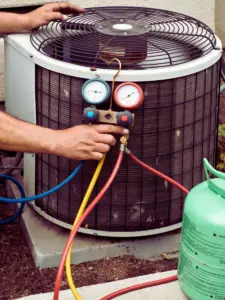 What’s the difference between Freon, R-410A, and R-454B? It’s a common question among those dealing with air conditioning and refrigeration systems. This article will dive into the specifics of these refrigerants, their uses, and why they matter. Now let’s break it down to understand these chemicals better…
What’s the difference between Freon, R-410A, and R-454B? It’s a common question among those dealing with air conditioning and refrigeration systems. This article will dive into the specifics of these refrigerants, their uses, and why they matter. Now let’s break it down to understand these chemicals better…
What is Freon?
Freon is a trade name synonymous with CFCs (chlorofluorocarbons) and HCFCs (hydrochlorofluorocarbons). Historically, Freon was used extensively in air conditioning and refrigeration systems. It became a household name in the mid-20th century. However, due to its high ozone depletion potential, the world started phasing it out in the 1980s.
Historical Use and Planned Phase-Out
Freon was everywhere. From your home air conditioner to supermarket refrigerators, it played an important role. But, the environmental impact couldn’t be ignored.
The timeline of this phase-out has seen various regulations, with significant milestones aimed at reducing environmental harm. The phase-out began with the Montreal Protocol, a landmark treaty that laid the groundwork for eliminating substances that deplete the ozone layer.
Refrigerant Numbering System
The ASHRAE (American Society of Heating, Refrigerating and Air-Conditioning Engineers) designation system assigns R-numbers to refrigerants. This system helps in identifying the molecular composition of refrigerants. Common refrigerants include R-22 (Freon), R-410A, and newer alternatives like R-454B.
Examples and Molecular Compositions
Understanding these numbers is essential. For example, R-22 is a hydrochlorofluorocarbon (HCFC), while R-410A is a hydrofluorocarbon (HFC). The numbers tell us about their chemical structures and the types of bonds between atoms. These details influence how refrigerants perform and their environmental impact.
What is R-410A?
 R-410A was developed by Honeywell International in response to the Montreal Protocol of 1987. This international treaty aimed to reduce substances that deplete the ozone layer. R-22, a widely used refrigerant, needed a replacement due to these regulatory shifts, leading to the development of R-410A.
R-410A was developed by Honeywell International in response to the Montreal Protocol of 1987. This international treaty aimed to reduce substances that deplete the ozone layer. R-22, a widely used refrigerant, needed a replacement due to these regulatory shifts, leading to the development of R-410A.
The Montreal Protocol
The Montreal Protocol was a game-changer. Signed in 1987, its goal was to phase out the production and consumption of ozone-depleting substances. The treaty has been remarkably successful, with significant reductions in CFCs and HCFCs. This paved the way for safer alternatives like R-410A.
The Role of HCFCs and the Phase-Out of R-22
R-22 was once the go-to refrigerant for many applications. However, due to its high ozone depletion potential, it became a target for phase-out under the Montreal Protocol.
This shift required the HVAC industry to adopt new refrigerants like R-410A, which offered similar performance with less environmental impact.
Properties & Applications of R-410A
Chemical Composition
R-410A is an HFC (hydrofluorocarbon) composed of R-32 and R-125. It’s classified as a near-azeotropic refrigerant blend, meaning it has minimal glide, which is a change in temperature during phase change at constant pressure. This stability makes it a preferred choice for many HVAC systems.
Classification and Physical Characteristics
As a near-azeotropic blend, R-410A has properties that make it efficient for cooling. It doesn’t separate into its component gases, which maintains efficiency and performance.
Primary Uses
R-410A is commonly used in both commercial and residential HVAC systems. It offers significant advantages over R-22, including better energy efficiency and less environmental harm. It’s found in many new air conditioning systems and heat pumps, offering reliable cooling and heating.
Advantages Over Previous Refrigerants
R-410A has several benefits over older refrigerants. It’s more efficient, which can reduce energy bills. It also has a lower ozone depletion potential, making it a more environmentally friendly option.
Additionally, its widespread adoption has made it readily available and cost-effective.
Future Outlook for R-410A
R-410A has played a huge role in modern HVAC systems. However, the balance between its ozone and climate impacts continues to be discussed. The HVAC industry is always looking for more sustainable options and innovations.
What is R-454B?
R-454B, marketed under the trade name Opteon XL41™ by Chemours, emerged in the late 2010s. It was developed as a lower GWP (global warming potential) alternative to R-410A.
The motivation behind R-454B’s development was driven by environmental regulations, such as the AIM Act of 2020, which gives the EPA authority over HFCs.
Comparison with R-410A
R-410A has dominated the market since the phase-out of R-22. However, with a global warming-potential (GWP) of 466, R-454B presents a significantly lower environmental impact compared to R-410A’s GWP range of 1890-2100. This makes R-454B a more attractive option for reducing greenhouse gas emissions.
Properties of R-454B
Chemical Composition
R-454B is a zeotropic blend of R-32 and R-1234yf. Unlike azeotropic blends like R-410A, zeotropic blends have a temperature glide during phase change. This means that as the refrigerant evaporates or condenses, the temperature changes slightly, which can affect performance but also offers benefits in certain applications.
Zeotropic vs. Azeotropic Blends
Azeotropic blends like R-410A have minimal temperature glide, making them stable and predictable. Zeotropic blends, on the other hand, have glide, which can be advantageous in specific scenarios. Understanding these differences is key to choosing the right refrigerant for your needs.
Glide and Performance Implications
Glide refers to the range of temperatures at which a refrigerant changes phase. R-454B has a glide value of 1.5°F, which impacts how it performs in HVAC systems. This slight glide can improve heat transfer efficiency in certain systems.
Environmental Impact of R-454B
R-454B offers improved energy efficiency and reduces greenhouse gas emissions. With a significant reduction in GWP compared to R-410A and no ozone depletion potential, it meets EPA requirements for low-GWP refrigerants. This positions R-454B as a leading option for future HVAC systems.
Identifying Refrigerant Type in Existing HVAC Systems
 To determine your system’s refrigerant, consider the age of the system. Units installed pre-2010 likely use R-22, while those post-2010 probably use R-410A. You can also consult your HVAC technician, check the owner’s manual, or examine the data plate on the outdoor unit.
To determine your system’s refrigerant, consider the age of the system. Units installed pre-2010 likely use R-22, while those post-2010 probably use R-410A. You can also consult your HVAC technician, check the owner’s manual, or examine the data plate on the outdoor unit.
Methods to Identify the Refrigerant Type
Several methods can help identify your refrigerant. Consulting an HVAC technician is the most straightforward approach. They can quickly determine the type based on their expertise and the system’s specifications.
Alternatively, checking the owner’s manual or the data plate on the outdoor unit can provide the necessary information.
Continued Service for Older Systems
Older systems using R-22 can still be serviced as stockpiled supplies of older refrigerants are available.
However, transitioning to newer refrigerants is advisable for long-term benefits. Upgrading your system can improve efficiency, reduce environmental impact, and potentially lower operating costs.
Transitioning to Newer Refrigerants
When selecting new systems, look for those using R-454B. Transitioning to more sustainable and energy-efficient refrigerants offers long-term environmental and economic benefits. New systems designed for R-454B are optimized for performance and efficiency.
To understand refrigerant transitions, it’s wise to seek professional advice. HVAC technicians at Service Minds One Hour in Daytona, FL, can guide you through the process. They offer insights into the latest technologies and can help you make informed decisions about your HVAC system.
Final Thoughts
R-454B is setting new standards in the HVAC industry with its environmental benefits and performance efficiencies. The future looks bright for R-454B as it becomes more standardized across the industry. As technology advances, we can expect even more efficient and eco-friendly refrigerants to emerge.
Give Service Minds One Hour a Call
 Questions about the refrigerants and how they affect your HVAC system? Give Service Minds One Hour in Daytona, FL, a call. They can assist with AC repairs, maintenance, or installation. Remember, “We’re always on time or you don’t pay a dime.”
Questions about the refrigerants and how they affect your HVAC system? Give Service Minds One Hour in Daytona, FL, a call. They can assist with AC repairs, maintenance, or installation. Remember, “We’re always on time or you don’t pay a dime.”
FAQs
What is Freon?
Freon is a trade name for CFCs and HCFCs used historically in air conditioning and refrigeration systems.
Why was Freon phased out?
Freon was phased out due to its high ozone depletion potential, starting in the 1980s.
What is R-410A?
R-410A is an HFC refrigerant developed as an alternative to R-22, known for its energy efficiency and lower environmental impact.
What is R-454B?
R-454B is a newer refrigerant with a lower GWP than R-410A, developed by Chemours under the trade name Opteon XL41™.
How do I know which refrigerant my HVAC system uses?
Check the age of your system, consult the owner’s manual, or ask an HVAC technician.
Why is R-454B considered better for the environment?
R-454B has a lower GWP and no ozone depletion potential, making it more environmentally friendly compared to older refrigerants.
Can older systems using R-22 still be serviced?
Older systems can still be fixed because there is still R-22 available, but it’s better to switch to newer refrigerants.
What are the benefits of transitioning to R-454B?
Transitioning to R-454B offers improved energy efficiency, reduced environmental impact, and long-term cost savings.
How do zeotropic blends differ from azeotropic blends?
Zeotropic blends have a temperature glide during phase change, while azeotropic blends have little to no glide.
Is R-454B flammable?
R-454B is classified as mildly flammable, which is a consideration in its use and handling.
What is the Montreal Protocol?
The Montreal Protocol is a 1987 international treaty aimed at reducing substances that deplete the ozone layer.